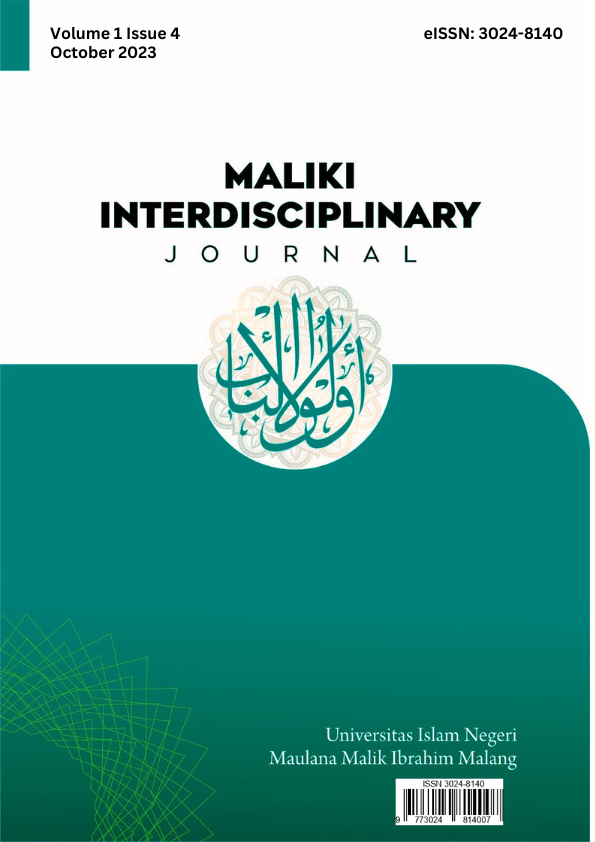Perkembangan Gamelan Jawa di Nusantara
Abstract
This study aims to examine the development of Javanese gamelan as an Islamic cultural heritage in Indonesia. Javanese Gamelan is a traditional musical ensemble that has an important role in the cultural life of the Javanese people. In this context, this research focuses on the role and influence of Islam in the development and transformation of Javanese gamelan. The research method used is historical research and musical analysis. Historical research involves studying documents, literature, and archives related to the role of Javanese gamelan in the context of Islam in Indonesia. These sources include performance records, religious records, and relevant historical literature. In addition, musical analysis is used to understand the musical structure of Javanese gamelan and changes in musical composition and style over time. The results of this study indicate that Javanese gamelan has experienced strong development in the context of Islamic culture in Indonesia. The role of Islam in the development of Javanese gamelan is seen in the influence of Islamic texts on the gamelan repertoire, the use of melodies and themes that reflect Islamic values, and changes in musical styles that are more related to religious practices. This research also highlights efforts to preserve and develop Javanese gamelan as an Islamic cultural heritage. Various communities, institutions and individuals have contributed to maintaining and reviving the Javanese gamelan tradition with Islamic influences.
Downloads
References
Alif, N., Islam, U., Sunan, N., Surabaya, A., Mafthukhatul, L., Islam, U., Sunan, N., Surabaya, A., Ahmala, M., Tinggi, S., Islam, A., Surabaya, T., Jawa, B., & Islam, B. (2020). Akulturasi Budaya Jawa Dan Islam. 23(2), 143–162.
Aryanto, A. S. (2018). Gamelan Soepra: Konsep dan Perilaku Musikal untuk Mencapai Tujuan Pendidikan. Journal of Music Science, Technology, and Industry, 1(1), 111. https://doi.org/10.31091/jomsti.v1i1.507
F.Kobi, M. (2017). Campursari : bentuk lain dari kesenian gamelan yang diterima di masa modern. Warna, 1(1), 1–20.
Fitriah, A. (2015). Pemikiran Abdurrahman Wahid tentang Pribumisasi Islam. Teosofi: Jurnal Tasawuf Dan Pemikiran Islam, 3(1), 39. https://doi.org/10.15642/teosofi.2013.3.1.39-59
Hananto, F. (2020). Gamelan Sebagai Simbol Estetis Kebudayaan Masyarakat Jawa. Representamen, 6(01). https://doi.org/10.30996/representamen.v6i01.3511
Hayati, N. R. (2018). Upaya pesantren dalam melestarikan seni budaya nusantara (Studi Kasus di Pondok Pesantr en “Wali Songo” Ngabar Ponorogo ).
Hidayati, K. H., & Nafiiyah, N. N. (2017). Aplikasi Alat Musik Tradisional Gamelan Jawa Berbasis Android. Jurnal Teknika, 9(1), 10. https://doi.org/10.30736/teknika.v9i1.3
Hudayana, B. (2021). Pengembangan Seni-Budaya sebagai Penguatan Identitas Komunitas Kejawen dan Santri di Desa pada Era Reformasi. Satwika : Kajian Ilmu Budaya Dan Perubahan Sosial, 5(1), 1–17. https://doi.org/10.22219/satwika.v5i1.15641
Ismail, M. (2013). Strategi Kebudayaan: Penyebaran Islam Di Jawa. IBDA` : Jurnal Kajian Islam Dan Budaya, 11(1), 46–60. https://doi.org/10.24090/ibda.v11i1.67
Kristanto, A. (2022). Penggunaan Gamelan dalam Perspektif Pendidikan Seni di Era 4.0. Clef : Jurnal Musik Dan Pendidikan Musik, 3(2), 78–86. https://doi.org/10.51667/cjmpm.v3i2.1073
Kurniawati, A., Ramli, M., & Iswahyudi, D. (2021). Metode Bermain Gamelan Jawa Untuk Meningkatkan Kerjasama Anak. JDidactica: Urnal Kajian Pendidikan Dan Pembelajaran, 1(1), 17–20.
M. Lutfi Mahasinul A, D. A. A. G. S. (2020). Aplikasi Pengenalan Alat Musik Gamelan Jawa. Transformasi, 16(1), 43–53. https://doi.org/10.56357/jt.v16i1.215
Machmudah, U. (2016). Budaya Mitoni (Analisis Nilai- Nilai Islam Dalam Membangun Semangat Ekonomi). El-Harakah, 18(2), 185. https://doi.org/10.18860/el.v18i2.3682
Mariyana, I. N. (2021). Tantangan dan Upaya Pelestarian Gamelan Gambang di Masa Depan. Bali-Dwipantara Waskita, 126–132. https://eproceeding.isi-dps.ac.id/index.php/bdw/article/view/249
Mulyono, A. S. (2012). Pengaruh Islam terhadap Perkembangan Budaya Jawa: tembang Macapat. El-Harakah, 14(1), 101–114. https://doi.org/10.18860/el.v0i0.2196
So’imah, N. F., Pravitasari, N. V., & Winaryati, E. (2020). Analisis Praktik-Praktik Islam Kejawen terhadap Kehidupan Sosial Masyarakat Era Modern (Studi Kasus di Desa X Kabupaten Grobogan). Sosial Budaya, 17(1), 64. https://doi.org/10.24014/sb.v17i1.9092
Suarez, L. Y. T. (2015). Pengembangan multimedia pembelajaran interaktif pokok bahasan “alat musik gamelan” untuk pembelajaran Bahasa Jawa sekolah dasar kelas V. 1, 1–27.
Sunarto, S. (2018). Claude Debussy dan Gamelan Jawa. In Pelataran Seni (Vol. 3, Issue 1, p. 1). https://doi.org/10.20527/jps.v3i1.5210
Widyastuti, I. (2022). Gema Bilah Kaca: Bentuk Inovasi Gamelan Sebagai Upaya Pelestarian Budaya di Kabupaten Pacitan. Virtuoso: Jurnal Pengkajian Dan Penciptaan Musik, 5(2), 104–109. https://doi.org/10.26740/vt.v5n2.p104-109
Wikantomo, H. (2022). Meninjau Penerapan Model Pembelajaran Gamelan Jawa Tingkat Sekolah Menengah Pertama Berdasar Kurikulum 2013 Reviewing the Implementation of the Javanese Gamelan Learning Model at the Junior High School Level Based on the 2013 Curriculum. 12(2), 60–75.
Copyright (c) 2023 Nur Diana Kholidah

This work is licensed under a Creative Commons Attribution-NonCommercial-ShareAlike 4.0 International License.
- Authors retain copyright and grant the journal right of first publication with the work simultaneously licensed under a Creative Commons Attribution License that allows others to share the work with an acknowledgement of the work’s authorship and initial publication in this journal.
- Authors are able to enter into separate, additional contractual arrangements for the non-exclusive distribution of the journal’s published version of the work (e.g., post it to an institutional repository or publish it in a book), with an acknowledgement of its initial publication in this journal.
- Authors are permitted and encouraged to post their work online (e.g., in institutional repositories or on their website) prior to and during the submission process, as it can lead to productive exchanges, as well as earlier and greater citation of published work.





